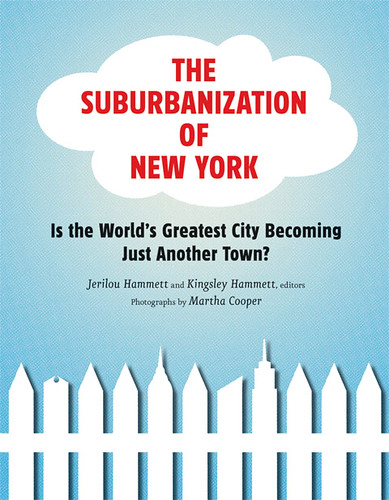Suburbanizing the City

In "CITY BLOCKS LIKE SHOPPING MALLS : A new book helps make sense of un-cosmopolitan currents washing over Gotham," City Limits reports on a new book from Princeton Architectural Press, The Suburbanization of New York: Is the World's Greatest City Becoming Just Another Town?; Edited by Jerilou Hammett and Kingsley Hammett; $24.95.
From the article:
On the one hand, we like the abundance of restaurants and stores on almost every major street and avenue in Manhattan, as well as the revitalized Steinway Streets and Flatbush Avenues in the outer boroughs; we like the lower crime rates that come with more street activity and the lack of noxious fumes emitted by a dwindling manufacturing sector. On the other hand, we’re concerned about skyrocketing real estate prices, gentrifying neighborhoods, and the slow disappearance of mom-and-pop stores in favor of brand name outlets owned by multinational corporations.
But it’s worth thinking more about why these things bother us so. To some, like Mayor Bloomberg, complaints like these are bound to sound a bit rich, like the moanings of a 3-year-old who has a sour stomach from eating too many sweets. “If you want to solve the problem of gentrification,” he and Doctoroff like to say, “then you should have crime go up, the schools get worse, and the parks get dirtier.” And they’re right, at least, to suggest that the burden of proof is on those of us who have a problem with high real estate values and an abundance of capital investment. Think of the alternative.
This is the explanatory gap that “The Suburbanization of New York” seeks to fill through 14 essays by a varied group of authors. Artists such as Lucy Lippard and Maggie Wrigley give first-person accounts of the gentrification of Soho, the East Village and the Lower East Side (and their own unwitting participation in it), while cultural theorists and urbanists such Neil Smith, Marshall Berman and Michael Sorkin – heavy hitters all – provide a more analytical perspective.
Sorkin, director of the graduate urban design program at CUNY, points out that New York has done a better job than most cities of protecting historic buildings and keeping its urban fabric mostly intact. And if Manhattan is steadily decreasing in density – as measured by the number of people of who actually live there – its vibrant street life is not likely to diminish anytime soon.
“If suburbanization – or globalization – threatens the city,” writes Sorkin, “the main danger comes not from the physical side of the equation, the introduction of specific alien architectures from suburbia – big boxes, ranch houses, shopping malls, etc. – but from the content side, which has proven adaptable enough to remain independent of the constraints of its setting.”
Take 125th Street in Harlem, for example. At one time it was the cultural and political heart of the African diaspora, teeming with street vendors selling wares to locals. Now, in the eyes of many of its older residents, it’s looking and feeling more and more like a traditional suburban mall. But it's not because the streetscape has been leveled or the building types altered.
----------------------
In DC, we lose both ways, both in terms of the aggressive suburbanization and bastardization of the builidng stock, as well as on "the content side" which is strong, while our culture of independent business and arts is weak, having been battered by 30-50 years of disinvestment (30 years downtown, 50 years for other parts of the city), and now 5-20 years of aggressive commodification of the public space, and homogenization of the retail offer in many parts of the city, especially downtown, and in the core of Georgetown.
Labels: building a local economy, civic engagement, economic development, retail



0 Comments:
Post a Comment
<< Home